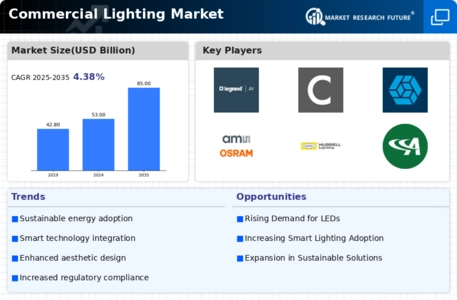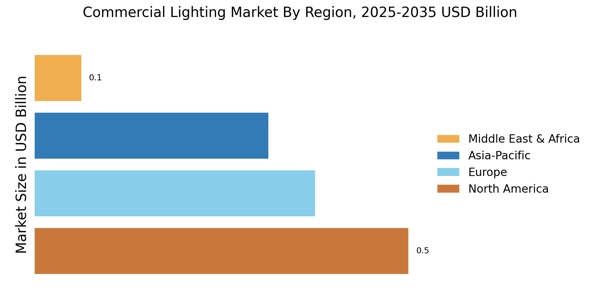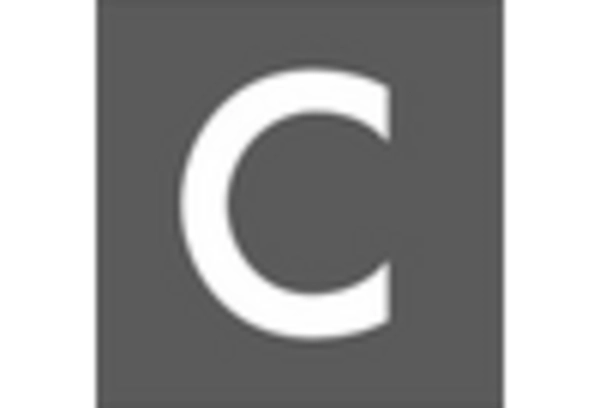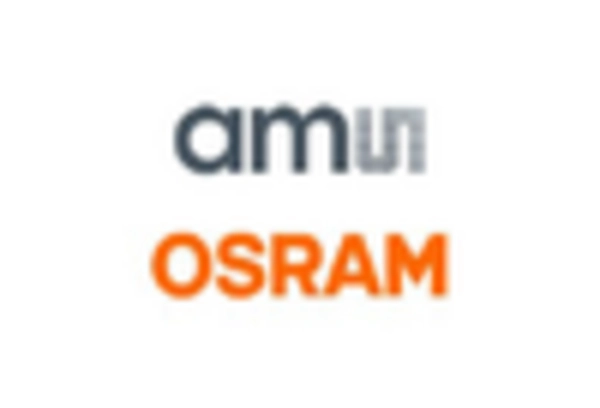Expansion of Smart Building Initiatives
The rise of smart building initiatives is a significant driver in the Commercial Lighting Market. As more businesses invest in smart technologies, the demand for integrated lighting solutions that can be controlled remotely is increasing. Smart lighting systems offer enhanced energy management, allowing businesses to optimize their lighting usage based on occupancy and natural light levels. This trend is particularly relevant in commercial spaces where energy efficiency is paramount. The market is projected to grow as smart building technologies become more prevalent, with estimates indicating that smart lighting could represent a substantial portion of the overall lighting market by 2028. This expansion reflects the growing importance of intelligent solutions in the Commercial Lighting Market.
Regulatory Support for Energy Efficiency
Regulatory frameworks promoting energy efficiency are significantly influencing the Commercial Lighting Market. Governments are implementing stringent energy efficiency standards and incentives to encourage the adoption of energy-saving lighting solutions. For instance, regulations mandating the phase-out of incandescent bulbs have accelerated the shift towards more efficient alternatives like LEDs. This regulatory support is expected to drive market growth, as businesses seek compliance while also benefiting from reduced energy costs. The market is projected to witness a surge in demand for energy-efficient lighting solutions, with estimates suggesting that energy-efficient lighting could account for over 60% of the market share by 2027.
Increased Focus on Sustainability Practices
Sustainability has become a pivotal concern for businesses, significantly impacting the Commercial Lighting Market. Companies are increasingly adopting sustainable practices, including the use of eco-friendly lighting solutions. This shift is driven by consumer preferences for environmentally responsible products and the need to reduce carbon footprints. The market is seeing a rise in demand for products that are not only energy-efficient but also made from sustainable materials. As businesses strive to align with sustainability goals, the adoption of green lighting solutions is expected to grow, potentially leading to a market expansion of over 15% in the coming years. This focus on sustainability is reshaping the landscape of the Commercial Lighting Market.
Technological Advancements in Lighting Solutions
The Commercial Lighting Market is experiencing a notable shift due to rapid technological advancements. Innovations such as LED technology and smart lighting systems are transforming traditional lighting solutions. The integration of Internet of Things (IoT) capabilities allows for enhanced control and energy management, which is increasingly appealing to businesses aiming to reduce operational costs. According to recent data, the adoption of LED lighting is projected to grow at a compound annual growth rate of over 10%, indicating a strong trend towards energy-efficient solutions. This technological evolution not only improves energy efficiency but also enhances the overall user experience, making it a critical driver in the Commercial Lighting Market.
Growing Demand for Aesthetic and Functional Lighting
The Commercial Lighting Market is increasingly influenced by the demand for aesthetic and functional lighting solutions. Businesses are recognizing the importance of lighting in enhancing the ambiance and functionality of their spaces. This trend is particularly evident in sectors such as retail and hospitality, where lighting plays a crucial role in customer experience. The market is witnessing a rise in demand for decorative lighting fixtures that not only serve a practical purpose but also contribute to the overall design of a space. As a result, manufacturers are focusing on creating innovative designs that blend aesthetics with functionality, thereby driving growth in the Commercial Lighting Market.

















Leave a Comment